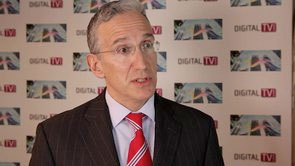
After more than 40 years of operation, DTVE is closing its doors and our website will no longer be updated daily. Thank you for all of your support.
Mobile viewing will drive bandwidth demand, ANGA COM attendees told
While linear TV is still the dominant form of TV consumption in Germany, viewing on mobile devices either via WiFi or LTE is growing massively and there will be a need for ever greater availability of bandwidth, according to a panel of TV operators and broadcasters at ANGA COM this morning.
Manuel Cubero, chief commercial officer, Vodafone Deutschland, said that video accounted for 60% of bandwidth in Germany, lower than in other European countries but catching up. Mobile consumption is growing more rapidly than fixed, he said.
Cubero said that a few devices used in parallel meant that users would require multi-Gigabit connections. “Vodafone is offering the whole range – cable, the biggest data autobahn, and mobile networks. The general tendency is towards mobility. Customers will ask if they can watch their shows wherever they want but the effort for network owners [to cope with this] will be enormous. However, there will be a seamless experience. Data consumption is increasing. The biggest share of video data is still in our TV spectrum – but mobile will catch up,” said Cubero.
Lutz Schuler, CEO of Liberty Global-owned cable operator Unitymedia, said that it was now commonplace that all available bandwidth is consumed. “We will take it for granted that a single household will have an 8Gbps line,” he said, adding that cable would play the key role in Germany. “How many homes are connected to optical fibre? One per cent. Seventy-five per cent are connected to cable and will have DOCSIS 3.1 soon. We don’t have to plough EUR80-90 million into the ground [to connect everyone].”
Schuler said that WiFi, which is “practically ignored” in Germany, would also play a key role. “We don’t have a mobile network. We have a cable network and we put up some antennas,” he said. He said that tests showed the user experience in public WiFi is good and enables people to consume video without reaching their mobile data limits.
Schuler said that Unitymedia covered 75% of the population in areas where it is present with fixed networks. “We can also offer 250Mbps and not 50Mbps,” he said.
Michael Hagspihl, CEO, residential, Telekom Deutschland, said that Deutsche Telekom was “also a cable network operator” through its partnerships with housing associations with in-building coax infrastructure. However, he said that Telekom was using advanced copper technologies to make high-speed services available more widely. “We are investing in copper networks every year and there will be vectoring technologies and super vectoring technologies not only in retail but in wholesale. That is the technology we rely on. Optical fibre is important. Customers don’t have it yet but if we look at the users, with more members of the family wanting to watch TV at the same time, we will have to expand the bandwidth.”
Hagspihl said that mobile coverage would keep improving. Mobile users also had access to Deutsche Telekom WiFi hotspots for free, he said. “We are giving users every option. LTE and WiFi must be combined.”
Speaking on the same panel, Conrad Albert, head of legal, distribution and regulatory affairs at ProSiebenSat.1, said that broadcasters had moved further away from traditional ‘camp fire’ viewing towards mobile platforms. He said the reach of linear and non-linear viewing combined is now “phenomenal”.
Albert said that linear TV is still necessary. He said that if all views of Germany’s Next Top Model had been online, the network would not have been able to cope.
Albert said that Germans are watching more linear TV than ever before. “Linear TV will for the foreseeable future be the medium. Mobile will be next. We need shorter format content for that and shorter advertising messages. If you take these two trends this means that content will require more bandwidth, particularly in mobile.”
Tom Buhrow, chief executive of regional public broadcaster WDR, said that “linear TV is still the king”, adding that broadcasters have limited distribution budgets. For the web, the more people that use content, the higher the cost, he said. “You have to invest more to reach more and this is something that we can’t forget.”



